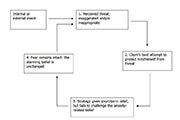Safety seeking behaviours are behaviours that you develop in response to feeling threatened. They help you, in the short term, to reduce the levels of anxiety that you are experiencing. For example, if you dread public speaking, you might come up with an excuse to avoid an event where you will have to speak in public, or if you have a great fear of disease, you might develop obsessive compulsive feelings around behaviours such as washing your hands or avoiding coming into contact with potential contagions.
On an immediate level, behaviours like this may seem to be useful because they remove the factor that is causing you anxiety and you may experience a sense of relief about having managed to avoid something that you find stressful. Over time, however, safety-seeking behaviours can become extremely disruptive and even lead to exaggerated fears of situations that do not actually pose any objective threat to your well-being.
People with a range of anxiety disorders often display safety-seeking behaviours as a maladaptive response to the negative feelings that they are experiencing. People with a condition such as agoraphobia are displaying an extreme form of safety seeking behaviour. To keep themselves safe, they do whatever they can to remove themselves from society completely. While they might feel safer on an immediate level, obviously over time their behaviours have the effect of seriously damaging their quality of life. People with anxiety disorders may also try to reduce perceived risks for their loved ones, such as children or other family members. In the process, they can contribute to others developing a heightened and unrealistic sense of risk.
When you allow yourself to engage in safety seeking behaviours in response to perceived threats, you are actually allowing yourself to feel more afraid and anxious. You are focusing on your symptoms of anxiety at the expense of other emotions. You constantly examine what is happening, around you and in your own mind, that might cause you to experience negative feelings. You can become permanently attuned to negativity, and in a constant state of incipient panic. If you reduce your social contact with others in response to feelings of anxiety, you eliminate potential support networks that would help you in difficult moments. By refusing to confront situations that make you feel anxious, you remove the possibility of learning that most of these situations do not actually pose a threat to you, and of figuring out how to cope with them in an adaptive way.
For all of these reasons, and more, it is essential that anyone who uses safety-seeking behaviours to manage anxiety learns a new, and more useful, approach to their situation.
If you suffer from anxiety and deal with it on your own by engaging in safety-seeking behaviours, you may need some help in breaking the cycle of negativity and avoidance that is stopping you from living your life as completely as you would wish. You can work with a Cognitive Behavioural Therapist to develop more useful coping mechanisms that will help you to manage your symptoms more effectively, and also to assess risk in a more realistic way.
References
Furukawa, T. A., Chen, J., Watanabe, N., Nakano, Y., Ietsugu, T., Ogawa, S., … Noda, Y. (2009). Videotaped experiments to drop safety behaviors and self-focused attention for patients with social anxiety disorder: Do they change subjective and objective evaluations of anxiety and performance? Journal of Behavior Therapy and Experimental Psychiatry, 40(2), 202–210. doi:10.1016/j.jbtep.2008.08.003
Kim, E. J. (2005). The effect of the decreased safety behaviors on anxiety and negative thoughts in social phobics. Journal of Anxiety Disorders, 19(1), 69–86. doi:10.1016/j.janxdis.2003.11.002
McManus, F., Sacadura, C., & Clark, D. M. (2008). Why social anxiety persists: An experimental investigation of the role of safety behaviours as a maintaining factor. Journal of Behavior Therapy and Experimental Psychiatry, 39(2), 147–161. doi:10.1016/j.jbtep.2006.12.002
Wells, A., Clark, D. M., Salkovskis, P., Ludgate, J., Hackmann, A., & Gelder, M. (1995). Social phobia: The role of in-situation safety behaviors in maintaining anxiety and negative beliefs. Behavior Therapy, 26(1), 153–161.
WHO CAN I SPEAK TO FURTHER ABOUT THE ISSUES IN THIS ARTICLE?
For help with the issues discussed in this article speak to one of our therapists here at Private Therapy Clinic for a free initial chat or to make an appointment.















